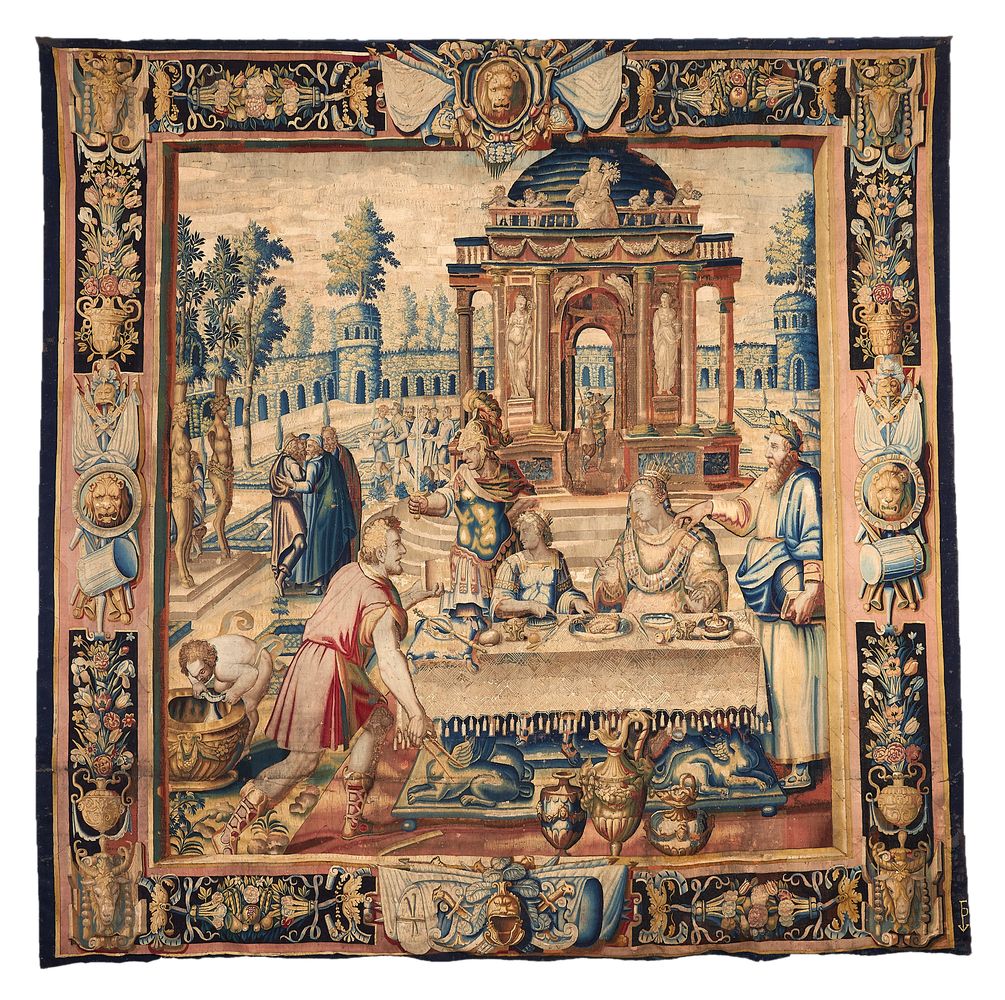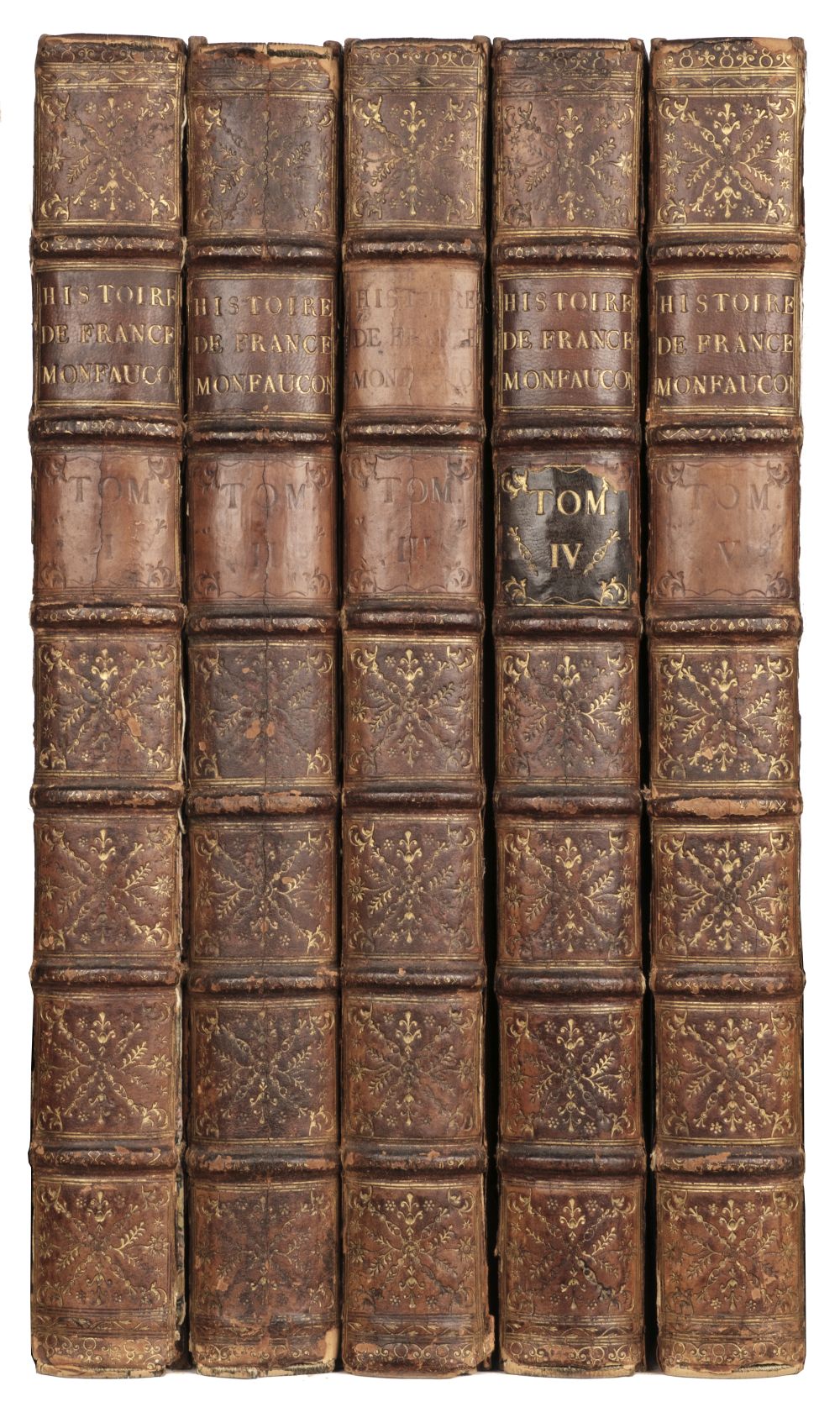A Paris historical tapestry, Faubourg Saint-Marcel workshops, woven by François de la Planche (Frans van der Planken), The Feast, or Artemisia Instructing her Architect , from The Story of Queen Artemisia , second quarter 17th century, to the design by Antoine Caron the central field with Artemisia, Lygdamis and entourage dining in a formal garden with architectural capriccio and balustrade; the border woven with lion's masks, trophies and flowering vases, weaver's mark FVP to the lower left selvedge, approximately 424cm square Provenance and published: Probably the panel sold at Sotheby's London, 25 March 1966, lot 16, the Property of a Gentleman The present piece is referred to in C. Adelson, European Tapestry in The Minneapolis Institute of Art, 1994, pp. 223-224, note 8, and K. Brosens, European Tapestries in the Art Institute of Chicago, 2008, p. 244 The present lot depicts a scene from the popular Artemisia series. The series was inspired by Nicolas Houel's L'histoire de la Royne Arthemise published in 1562, a collection of sonnets about the lives of two ancient Queens of Caria rolled into one protagonist, the first perhaps best known for commissioning the Mausoleum at Halicarnassus, the tomb of her husband Mausolus, and the second for providing an education to her son and acting as a ruler during his childhood (5th century BC). Houel's poems were said to glorify the life of Catherine de' Medici, who was also widowed after the loss of her husband King Henri II of France, and acted as Regent while her son Charles IX was a minor (the role of Charles in the story can be compared to that of Artemisia's son Lygdamis). The sonnets were accompanied by tapestry designs, most of which were created by Antoine Caron (1521-1599), painter to the King and part of the School of Fontainebleau. The episode depicted here, often referred to as 'the Feast', adheres relatively faithfully to the central section of the design by Caron, which is in the collection of the Musée du Louvre RF. 29728 bis3. However, the figural groups to the background and particularly the rear right corner have been omitted. Though inspired by mannerist designs, the tapestry cycle remained popular throughout the 17th century and various groups are recorded, including in the inventory made after the death of weaver Francois de la Planche in 1627, whose mark is woven into the right selvedge of the present lot. Seven various border designs of the series are recorded, and the 'lion and trophy' version was a popular choice. See for example a fragment of the present 'Feast' scene with similar border in the collection of the Art Institute of Chicago (Inv. 1890.10). Another series with a slight variety to the border also bearing the FVP weaver's mark is in the collection of the Residenz Munich, commissioned by the Archduke of Austria in the first quarter of the 17th century. Other sets with similar borders include the six panels at Eastnor Castle, Herefordshire, likely collected by the 3rd Earl Somers during the 19th century, as well as the five known panels originally from the Château de Suzanne possibly from the same set, most of which are now at the New Orleans Museum of Art. One of the pieces from the Suzanne set representing the present scene, referred to by Heinrich Göbel as as the 'Queen and her successor dining in the palace garden...' (1) has appeared on the art market, though it is likely not the panel presented here. Another set, originally from the Château de Noizay and likely the one requisitioned from Nicolas Fouquet by Louis XIV and previously installed at Chambord, is at the Hotel de Sully, Paris. Though most of these have lost their bottom borders, Bruno Saunier speculates that there may have originally been other pieces in this same set, such as the one preserved at the Musee du Louvre (2). Interestingly, the panel presented here shares strong similarities with the borders in this design, and may have once been part of a similar set. (1) B.
A Paris historical tapestry, Faubourg Saint-Marcel workshops, woven by François de la Planche (Frans van der Planken), The Feast, or Artemisia Instructing her Architect , from The Story of Queen Artemisia , second quarter 17th century, to the design by Antoine Caron the central field with Artemisia, Lygdamis and entourage dining in a formal garden with architectural capriccio and balustrade; the border woven with lion's masks, trophies and flowering vases, weaver's mark FVP to the lower left selvedge, approximately 424cm square Provenance and published: Probably the panel sold at Sotheby's London, 25 March 1966, lot 16, the Property of a Gentleman The present piece is referred to in C. Adelson, European Tapestry in The Minneapolis Institute of Art, 1994, pp. 223-224, note 8, and K. Brosens, European Tapestries in the Art Institute of Chicago, 2008, p. 244 The present lot depicts a scene from the popular Artemisia series. The series was inspired by Nicolas Houel's L'histoire de la Royne Arthemise published in 1562, a collection of sonnets about the lives of two ancient Queens of Caria rolled into one protagonist, the first perhaps best known for commissioning the Mausoleum at Halicarnassus, the tomb of her husband Mausolus, and the second for providing an education to her son and acting as a ruler during his childhood (5th century BC). Houel's poems were said to glorify the life of Catherine de' Medici, who was also widowed after the loss of her husband King Henri II of France, and acted as Regent while her son Charles IX was a minor (the role of Charles in the story can be compared to that of Artemisia's son Lygdamis). The sonnets were accompanied by tapestry designs, most of which were created by Antoine Caron (1521-1599), painter to the King and part of the School of Fontainebleau. The episode depicted here, often referred to as 'the Feast', adheres relatively faithfully to the central section of the design by Caron, which is in the collection of the Musée du Louvre RF. 29728 bis3. However, the figural groups to the background and particularly the rear right corner have been omitted. Though inspired by mannerist designs, the tapestry cycle remained popular throughout the 17th century and various groups are recorded, including in the inventory made after the death of weaver Francois de la Planche in 1627, whose mark is woven into the right selvedge of the present lot. Seven various border designs of the series are recorded, and the 'lion and trophy' version was a popular choice. See for example a fragment of the present 'Feast' scene with similar border in the collection of the Art Institute of Chicago (Inv. 1890.10). Another series with a slight variety to the border also bearing the FVP weaver's mark is in the collection of the Residenz Munich, commissioned by the Archduke of Austria in the first quarter of the 17th century. Other sets with similar borders include the six panels at Eastnor Castle, Herefordshire, likely collected by the 3rd Earl Somers during the 19th century, as well as the five known panels originally from the Château de Suzanne possibly from the same set, most of which are now at the New Orleans Museum of Art. One of the pieces from the Suzanne set representing the present scene, referred to by Heinrich Göbel as as the 'Queen and her successor dining in the palace garden...' (1) has appeared on the art market, though it is likely not the panel presented here. Another set, originally from the Château de Noizay and likely the one requisitioned from Nicolas Fouquet by Louis XIV and previously installed at Chambord, is at the Hotel de Sully, Paris. Though most of these have lost their bottom borders, Bruno Saunier speculates that there may have originally been other pieces in this same set, such as the one preserved at the Musee du Louvre (2). Interestingly, the panel presented here shares strong similarities with the borders in this design, and may have once been part of a similar set. (1) B.





.jpg)




.jpg)


Testen Sie LotSearch und seine Premium-Features 7 Tage - ohne Kosten!
Lassen Sie sich automatisch über neue Objekte in kommenden Auktionen benachrichtigen.
Suchauftrag anlegen